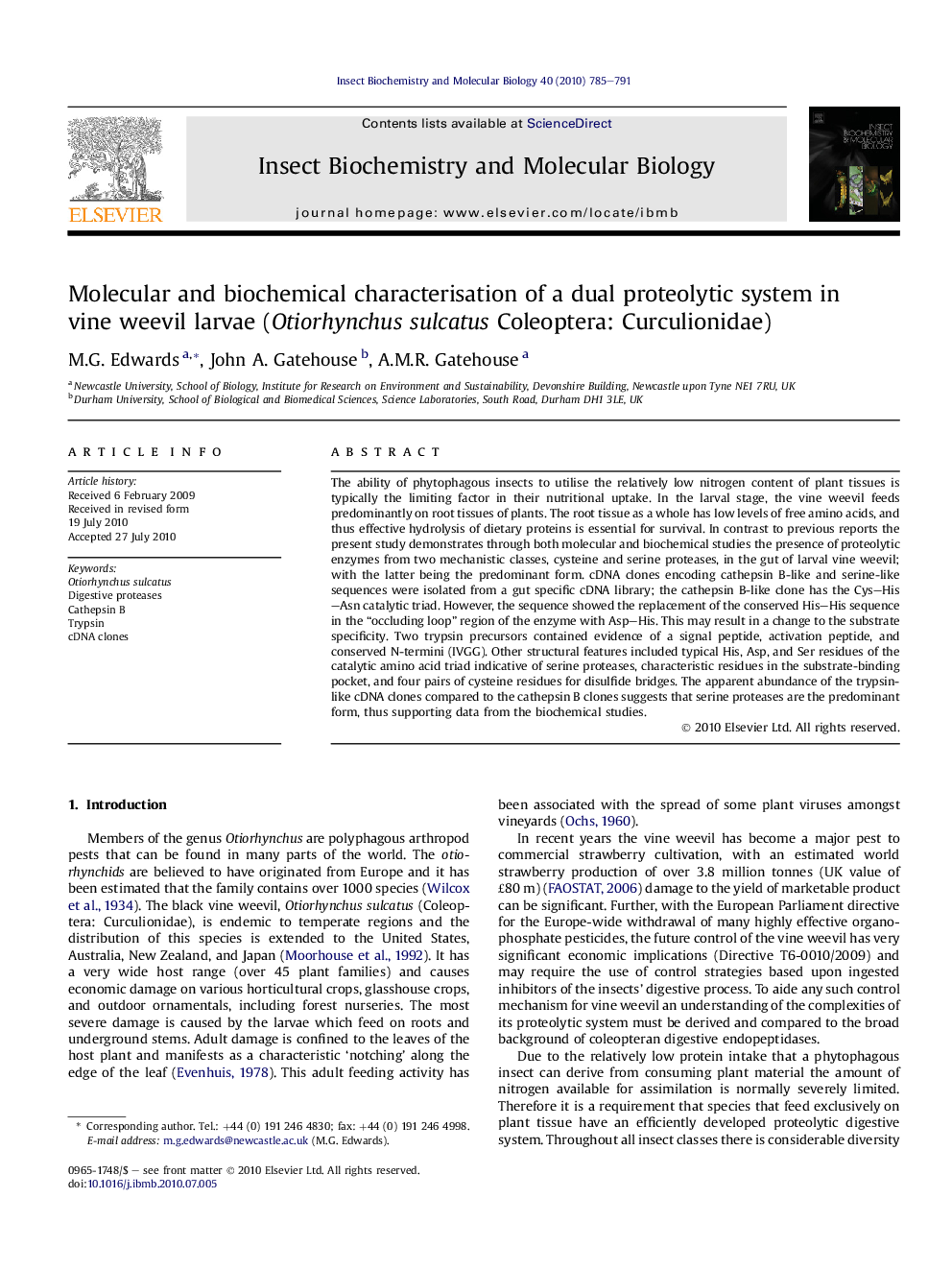| کد مقاله | کد نشریه | سال انتشار | مقاله انگلیسی | نسخه تمام متن |
|---|---|---|---|---|
| 1982506 | 1062293 | 2010 | 7 صفحه PDF | دانلود رایگان |

The ability of phytophagous insects to utilise the relatively low nitrogen content of plant tissues is typically the limiting factor in their nutritional uptake. In the larval stage, the vine weevil feeds predominantly on root tissues of plants. The root tissue as a whole has low levels of free amino acids, and thus effective hydrolysis of dietary proteins is essential for survival. In contrast to previous reports the present study demonstrates through both molecular and biochemical studies the presence of proteolytic enzymes from two mechanistic classes, cysteine and serine proteases, in the gut of larval vine weevil; with the latter being the predominant form. cDNA clones encoding cathepsin B-like and serine-like sequences were isolated from a gut specific cDNA library; the cathepsin B-like clone has the Cys–His–Asn catalytic triad. However, the sequence showed the replacement of the conserved His–His sequence in the “occluding loop” region of the enzyme with Asp–His. This may result in a change to the substrate specificity. Two trypsin precursors contained evidence of a signal peptide, activation peptide, and conserved N-termini (IVGG). Other structural features included typical His, Asp, and Ser residues of the catalytic amino acid triad indicative of serine proteases, characteristic residues in the substrate-binding pocket, and four pairs of cysteine residues for disulfide bridges. The apparent abundance of the trypsin-like cDNA clones compared to the cathepsin B clones suggests that serine proteases are the predominant form, thus supporting data from the biochemical studies.
The ability of phytophagous insects to utilise the relatively low nitrogen content of plant tissues is typically the limiting factor in their nutritional uptake. In the larval stage, the vine weevil feeds predominantly on root tissues of plants. The root tissue as a whole has low levels of free amino acids, and thus effective hydrolysis of dietary proteins is essential for survival. In contrast to previous reports the present study demonstrates through both molecular and biochemical studies the presence of proteolytic enzymes from two mechanistic classes, cysteine and serine proteases, in the gut of larval vine weevil; with the latter being the predominant form. cDNA clones encoding cathepsin B-like and serine-like sequences were isolated from a gut specific cDNA library; the cathepsin B-like clone has the Cys–His–Asn catalytic triad. However, the sequence showed the replacement of the conserved His–His sequence in the “occluding loop” region of the enzyme with Asp–His. This may result in a change to the substrate specificity. Two trypsin precursors contained evidence of a signal peptide, activation peptide, and conserved N-termini (IVGG). Other structural features included typical His, Asp, and Ser residues of the catalytic amino acid triad indicative of serine proteases, characteristic residues in the substrate-binding pocket, and four pairs of cysteine residues for disulfide bridges. The apparent abundance of the trypsin-like cDNA clones compared to the cathepsin B clones suggests that serine proteases are the predominant form, thus supporting data from the biochemical studies.Figure optionsDownload high-quality image (148 K)Download as PowerPoint slideResearch highlights
► Demonstration of proteolytic enzymes from two mechanistic classes, cysteine and serine proteases, in the gut of larval vine weevil.
► In vitro assays show gut proteolysis is sensitive to inhibitors.
► Cathespin B-like enzyme exhibits alteration to “occluding loop” region therefore may allow it to act as a more general digestive endopeptidase.
Journal: Insect Biochemistry and Molecular Biology - Volume 40, Issue 11, November 2010, Pages 785–791